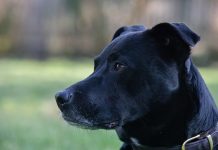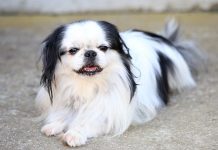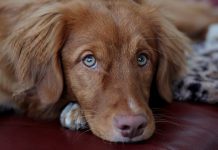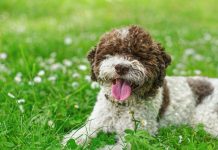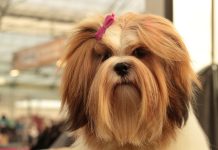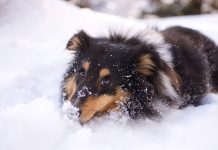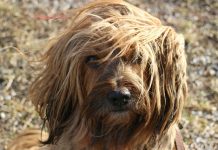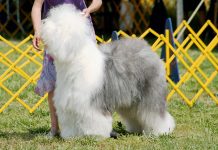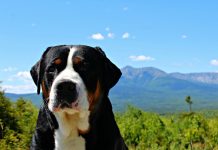History and Origins of the Neapolitan Mastiff Breed

The Neapolitan Mastiff is an ancient and imposing breed with a rich history dating back thousands of years. Here’s an overview of its fascinating history and origins:
- Ancient Roman Guardians: The Neapolitan Mastiff originated in ancient Italy, particularly in the region of Naples. They were descendants of ancient Molossian dogs used by the Romans as war dogs and guardians.
- War and Gladiator Dogs: Neapolitan Mastiffs were renowned for their strength and courage in battle. They were often employed by the Roman army as war dogs and were also used in gladiator arenas to fight alongside human warriors.
- Guardians of Estates and Properties: Over time, Neapolitan Mastiffs transitioned from war and gladiator roles to become trusted guardians of estates, farms, and properties in Italy. They were valued for their loyalty and protective instincts.
- Decline and Revival: By the mid-20th century, the Neapolitan Mastiff breed faced near extinction due to wartime and societal changes. However, dedicated breed enthusiasts worked to revive the breed, leading to its preservation and recognition.
- Modern Recognition: The Neapolitan Mastiff was officially recognized by the American Kennel Club (AKC) in 2004. Today, they are cherished as loyal family companions and impressive show dogs around the world.
Physical Characteristics and Appearance of Neapolitan Mastiffs
The Neapolitan Mastiff is a massive and muscular breed known for its distinctive appearance and impressive build. Here are the key physical characteristics and appearance traits of the Neapolitan Mastiff:
- Size: Neapolitan Mastiffs are large and heavy dogs, with males typically standing 26 to 31 inches (66 to 79 cm) at the shoulder and weighing 150 to 180 pounds (68 to 82 kg). Females are slightly smaller but still substantial in size.
- Build: The breed has a powerful and robust build, with a broad chest, strong limbs, and a deep, barrel-shaped body. They have a thick, wrinkled skin that forms loose folds, especially around the neck and face.
- Head: The most striking feature of the Neapolitan Mastiff is its massive head, which is large and wrinkled. They have a distinctive furrowed brow, deep-set eyes, and pendulous lips that contribute to their unique expression.
- Eyes: Neapolitan Mastiffs have medium-sized, almond-shaped eyes that are usually dark in color. The eyes are set deep in the skull, giving the breed a serious and watchful look.
- Ears: The breed’s ears are medium-sized, triangular, and often cropped to stand erect. Natural ears are triangular and hang close to the cheeks.
- Coat: Neapolitan Mastiffs have a short and dense coat that lies close to the body. The coat is straight and smooth, with a slightly coarse texture. Coat colors include solid black, blue, mahogany, and tawny, often with a darker mask.
- Wrinkles and Skin Folds: Neapolitan Mastiffs are known for their loose, wrinkled skin, especially around the neck, shoulders, and face. The wrinkles are a distinctive feature of the breed but require regular cleaning and maintenance to prevent skin issues.
- Tail: The breed’s tail is thick at the base and tapers to a point. The tail is usually carried straight or slightly curved and reaches to the hocks.
- Movement: Neapolitan Mastiffs have a unique and powerful gait, moving with a rolling, lumbering stride. Despite their size, they are surprisingly agile and capable of quick bursts of speed.
- Overall Impression: The Neapolitan Mastiff exudes strength, confidence, and dignity. They are noble and imposing dogs with a calm and steady demeanor, making them impressive guardians and devoted companions.
Neapolitan Mastiffs require proper care, training, and socialization to thrive as well-rounded companions. They are known for their loyalty, protective instincts, and affectionate nature towards their families. Understanding their unique characteristics and providing appropriate care is essential for owning a Neapolitan Mastiff.
Neapolitan Mastiff Temperament and Personality Traits
- Loyal and Protective: Neapolitan Mastiffs are deeply loyal and devoted to their families. They have a strong protective instinct and will act fearlessly to defend their loved ones and territory.
- Gentle Giants: Despite their imposing size and protective nature, Neapolitan Mastiffs are gentle giants with a calm and affectionate demeanor towards their family members.
- Reserved with Strangers: Neapolitan Mastiffs are typically wary and aloof around strangers. They make excellent watchdogs due to their alertness and suspicion of unfamiliar people.
- Courageous and Confident: This breed is known for its courage and confidence. Neapolitan Mastiffs are not easily intimidated and remain composed in challenging situations.
- Calm and Laid-Back: Neapolitan Mastiffs have a relaxed and laid-back attitude when at home. They enjoy lounging and spending quality time with their family.
- Independent Thinkers: Neapolitan Mastiffs can be independent and strong-willed. They require consistent leadership and positive reinforcement during training.
- Low Energy Level: While Neapolitan Mastiffs are not highly active dogs, they still benefit from regular exercise to maintain muscle tone and overall health. They enjoy leisurely walks and playtime.
- Affectionate: Neapolitan Mastiffs form strong bonds with their families and thrive on companionship. They enjoy being close to their owners and are known for their affectionate nature.
- Socialization Needs: Early and ongoing socialization is crucial for Neapolitan Mastiffs to prevent excessive shyness or aggression towards strangers. Expose them to different people, animals, and environments from a young age.
- Cautious with Children: Neapolitan Mastiffs can be gentle with children when raised together and properly socialized. However, supervision is always recommended due to their size and strength.
Training and Socialization Needs for Neapolitan Mastiffs
- Early Training: Start training your Neapolitan Mastiff puppy as soon as you bring them home. Use positive reinforcement techniques such as treats, praise, and play to motivate and reward good behavior.
- Consistent Leadership: Establish yourself as a calm and confident leader. Neapolitan Mastiffs respond well to assertive yet gentle training methods. Be patient and consistent with commands.
- Socialization: Expose your Neapolitan Mastiff to various people, animals, sounds, and environments from an early age. This helps them develop confidence and good manners.
- Guard Dog Training: Neapolitan Mastiffs have natural guarding instincts. Channel their protective nature through appropriate training to distinguish between welcome visitors and potential threats.
- Basic Obedience: Teach essential commands such as sit, stay, come, and heel. Practice obedience training regularly to reinforce good behavior and strengthen the bond between you and your dog.
- Positive Reinforcement: Use positive reinforcement techniques to encourage desired behaviors and discourage unwanted behaviors. Avoid harsh methods that can undermine their trust.
- Patience and Consistency: Neapolitan Mastiffs can be slow to mature mentally, so be patient and consistent with training. Keep training sessions short and engaging to maintain their interest.
- Early Socialization: Introduce your Neapolitan Mastiff to different experiences gradually. Encourage positive interactions with people, other dogs, and environments to build social confidence.
- Behavioral Management: Address behavioral issues promptly and seek professional guidance if needed. Neapolitan Mastiffs benefit from structured training and clear boundaries.
- Exercise and Mental Stimulation: Provide regular exercise and mental stimulation to keep your Neapolitan Mastiff physically and mentally healthy. Engage them in interactive games and activities that challenge their intelligence and instincts.
By understanding the temperament and training needs of Neapolitan Mastiffs, you can build a strong bond with your dog and ensure they grow up to be well-mannered and confident companions. Consistent training, socialization, and positive reinforcement are key to raising a happy and well-adjusted Neapolitan Mastiff.
Health Considerations and Common Issues in Neapolitan Mastiffs
- Joint Problems: Neapolitan Mastiffs are large and heavy-boned dogs, which can predispose them to joint issues such as hip dysplasia and elbow dysplasia. Regular veterinary check-ups and appropriate exercise can help manage and prevent these conditions.
- Bloat (Gastric Dilatation-Volvulus): This life-threatening condition can occur in deep-chested breeds like Neapolitan Mastiffs. Feeding multiple smaller meals throughout the day, avoiding exercise after meals, and recognizing early symptoms are crucial for prompt veterinary intervention.
- Skin Problems: Neapolitan Mastiffs have loose, wrinkled skin that requires regular care to prevent skin fold dermatitis and bacterial infections. Keep skin folds clean and dry, and consult your veterinarian for guidance on skincare.
- Eye Issues: Entropion (inward rolling of eyelids), cherry eye, and ectropion (outward rolling of eyelids) are common eye conditions in Neapolitan Mastiffs. Regular eye exams and prompt treatment can help prevent complications.
- Heart Disease: Some Neapolitan Mastiffs may be prone to heart conditions such as dilated cardiomyopathy (enlarged heart). Regular cardiac screenings are recommended, especially as they age.
- Hypothyroidism: This condition occurs when the thyroid gland doesn’t produce enough hormones, leading to symptoms like weight gain, lethargy, and skin problems. Regular blood tests can diagnose and manage hypothyroidism.
- Wobbler Syndrome: This neurological condition affects the spine, causing weakness and coordination issues. Neapolitan Mastiffs may be predisposed due to their size. Management may include medication, physical therapy, or surgery.
- Heat Sensitivity: Neapolitan Mastiffs are sensitive to heat due to their brachycephalic (short-nosed) facial structure. Avoid exercising them in hot weather and provide plenty of shade and water.
- Obesity: Neapolitan Mastiffs are prone to weight gain, which can exacerbate joint issues and other health problems. Monitor their diet and provide appropriate exercise to maintain a healthy weight.
- Cancer: Like many large breeds, Neapolitan Mastiffs may be at increased risk for certain cancers. Regular veterinary care and early detection are important for managing cancer.
Living with a Neapolitan Mastiff: Suitable Environments and Lifestyle Considerations
- Space: Neapolitan Mastiffs require ample indoor space due to their large size. They are not suited to apartment living and thrive in homes with a fenced yard where they can move around comfortably.
- Climate: Due to their sensitivity to heat, Neapolitan Mastiffs do best in moderate climates. Avoid exposing them to hot and humid weather, and provide air-conditioned areas during the summer.
- Exercise Needs: Neapolitan Mastiffs have moderate exercise needs. Daily walks and playtime in a safe area are sufficient to keep them healthy and mentally stimulated.
- Socialization: Early and ongoing socialization is crucial to prevent shyness or aggression towards strangers. Expose them to various people, animals, and environments from a young age.
- Grooming: Neapolitan Mastiffs require regular grooming, especially around skin folds. Clean skin folds with a damp cloth and keep them dry to prevent infections. Brush their coat weekly to remove loose hair.
- Training: Consistent and positive training methods are essential for Neapolitan Mastiffs. Start training early to establish good behavior and prevent undesirable habits.
- Family Interaction: Neapolitan Mastiffs thrive on companionship and bond closely with their families. They are loyal and protective, making them excellent guardians and family pets.
- Routine Veterinary Care: Schedule regular veterinary check-ups, vaccinations, and preventive care to monitor your Neapolitan Mastiff’s health and address any concerns promptly.
- Safety Precautions: Supervise interactions with children and other pets due to their size and protective nature. Teach children how to behave around dogs and never leave them unsupervised.
- Quality Diet: Feed your Neapolitan Mastiff a high-quality diet appropriate for their age, size, and activity level. Avoid overfeeding to prevent obesity and related health issues.
By understanding the health considerations and lifestyle needs of Neapolitan Mastiffs, you can provide them with a safe, comfortable, and fulfilling environment. Regular veterinary care, proper grooming, and attentive management are essential for ensuring a happy and healthy life for your Neapolitan Mastiff companion.
Neapolitan Mastiff Variations and Breeding Practices

The Neapolitan Mastiff breed is relatively standardized in terms of appearance and characteristics, with limited variations compared to some other breeds. However, responsible breeding practices are essential for maintaining the breed’s health, temperament, and conformation. Here are some insights into Neapolitan Mastiff variations and breeding practices:
Neapolitan Mastiff Variations:
- Coat Color: Neapolitan Mastiffs come in various coat colors, including solid black, blue, mahogany, tawny, and brindle. While coat color variations exist, the breed standard generally emphasizes solid colors.
- Size: Neapolitan Mastiffs can vary slightly in size, with males typically standing 26 to 31 inches (66 to 79 cm) at the shoulder and weighing 150 to 180 pounds (68 to 82 kg). Females are usually slightly smaller but still substantial.
- Head and Wrinkles: Although Neapolitan Mastiffs are known for their large heads and loose skin with wrinkles, there can be variations in the extent of wrinkles and the size and shape of the head within the breed.
- Temperament: While Neapolitan Mastiffs share common temperament traits such as loyalty, protectiveness, and affection, individual dogs may exhibit slight variations in personality based on genetics and upbringing.
Responsible Breeding Practices:
- Health Testing: Ethical breeders prioritize health testing to screen for genetic disorders such as hip dysplasia, elbow dysplasia, heart conditions, and eye problems. Breeding dogs should be certified clear of hereditary diseases.
- Temperament and Behavior: Responsible breeders select breeding stock with stable and predictable temperaments. They prioritize breeding dogs that exhibit the breed’s desired characteristics, including courage, loyalty, and protectiveness.
- Conformation to Breed Standard: Breeders adhere to the Neapolitan Mastiff breed standard set by kennel clubs and breed organizations. This includes emphasizing correct physical features such as head shape, body proportions, and coat color.
- Genetic Diversity: Maintaining genetic diversity is important to prevent inherited health issues and preserve the breed’s overall health and vitality. Responsible breeders carefully plan matings to minimize the risk of genetic disorders.
- Ethical Placement of Puppies: Reputable breeders prioritize the well-being of their puppies and carefully screen potential owners to ensure they can provide a suitable home. They educate puppy buyers about the breed’s needs and characteristics.
- Continued Education and Improvement: Dedicated Neapolitan Mastiff breeders stay informed about the latest research, health trends, and advancements in canine genetics. They actively participate in breed clubs and engage in ongoing education to improve breeding practices.
- Health Guarantees and Contracts: Responsible breeders provide health guarantees and written contracts to puppy buyers. They offer support and guidance throughout the dog’s life and are available to answer questions or address concerns.
- Ethical Marketing and Transparency: Reputable breeders are transparent about their breeding practices and provide documentation of health screenings, pedigrees, and genetic testing to puppy buyers. They prioritize the long-term health and welfare of the breed.
By supporting responsible breeding practices and working with reputable Neapolitan Mastiff breeders, enthusiasts can help preserve the breed’s heritage and ensure the health and well-being of future generations of Neapolitan Mastiffs. Ethical breeding practices contribute to the longevity and sustainability of the breed while promoting responsible pet ownership.
50 Best Names with Meanings for Neapolitan Mastiffs
Naming a Neapolitan Mastiff can be an exciting and meaningful process, especially considering their impressive stature and noble demeanor. Here are 50 best names with meanings that suit the Neapolitan Mastiff’s unique characteristics:
- Titan – Giant, fitting for a massive breed
- Athena – Greek goddess of wisdom and courage
- Hercules – Strong and heroic figure from mythology
- Bruno – Brown-haired, suitable for a Mastiff with a brown coat
- Vera – Truth or faith
- Magnus – Great and mighty
- Luna – Moon, representing beauty and grace
- Tank – Symbolic of strength and power
- Noble – Reflective of the breed’s regal presence
- Sable – Dark and dignified coat color
- Maximus – Greatest, perfect for a majestic Mastiff
- Stella – Star, shining and radiant
- Ragnar – Warrior or hero
- Astra – Star, symbolizing brightness and guidance
- Goliath – Biblical giant, symbolizing strength
- Ivy – Symbol of faithfulness and constancy
- Cyrus – Sun, representing warmth and strength
- Nova – New and brilliant
- Gunner – Strong and formidable
- Zara – Princess, elegant and regal
- Blaze – Bright and intense, perfect for a fiery personality
- Odin – Norse god of wisdom and war
- Juno – Roman goddess of protection
- Brutus – Strong and fierce
- Indigo – Deep blue hue, ideal for a blue-gray Mastiff
- Apollo – Greek god of sun and light
- Loki – Norse trickster god, mischievous and clever
- Zephyr – Gentle breeze
- Gunner – Bold and powerful
- Maverick – Independent and bold
- Sasha – Defender of mankind
- Diesel – Energetic and robust
- Helios – Greek god of the sun
- Zara – Princess, elegant and regal
- Rogue – Bold and adventurous
- Echo – Reflection or reverberation
- Kai – Strong and unbreakable
- Arya – Noble, great for a courageous dog
- Jax – God has been gracious, a powerful name
- Hunter – Skilled and alert
- Pharaoh – King of ancient Egypt, majestic and commanding
- Nyx – Greek goddess of the night, mysterious and powerful
- Rex – Latin for king, fitting for a regal breed
- Mars – Roman god of war
- Brunhilda – Noble and strong
- Onyx – Black gemstone, ideal for a dark-coated Mastiff
- Thor – Norse god of thunder, strong and powerful
- Venus – Roman goddess of love and beauty
- Zara – Princess, elegant and regal
- Khan – Ruler or king
Choose a name that resonates with your Neapolitan Mastiff’s personality, appearance, and the qualities you admire. Whether you prefer a strong and powerful name or a more elegant and meaningful name, there’s a perfect fit waiting for your majestic companion!
In conclusion, this comprehensive guide to Neapolitan Mastiff dogs has provided a detailed exploration of this unique and powerful breed. Throughout our discussion, we’ve delved into the history, distinctive characteristics, and essential care considerations that define Neapolitan Mastiffs. Known for their massive size, wrinkles, and protective nature, Neapolitan Mastiffs make devoted companions for experienced dog owners seeking a loyal and imposing pet. They require early socialization, consistent training, and regular exercise to thrive as well-rounded family members. As you embark on your journey with a Neapolitan Mastiff, may you appreciate their unique qualities and form a strong bond with this impressive breed, creating lasting companionship and fulfillment together.








